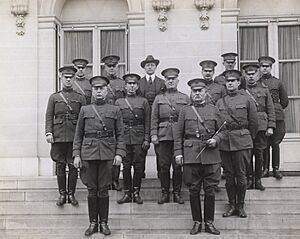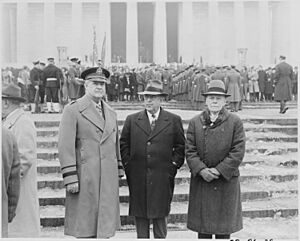Ulysses S. Grant III facts for kids
Quick facts for kids
Ulysses S. Grant III
|
|
|---|---|
 |
|
| Birth name | Ulysses Simpson Grant III |
| Born | July 4, 1881 Chicago, Illinois, U.S. |
| Died | August 29, 1968 (aged 87) Clinton, New York, U.S. |
| Allegiance | United States |
| Service/ |
United States Army |
| Years of service | 1903–1946 |
| Rank | Major general |
| Commands held | 1st Engineer Regiment Engineer Replacement Training Center Office of Civilian Defense |
| Battles/wars | Philippine–American War World War I World War II |
| Awards | Distinguished Service Medal Legion of Merit Légion d'honneur Croix de Guerre |
| Spouse(s) |
Edith Root
(m. 1907; |
| Children | 3 |
| Relations | Ulysses S. Grant (grandfather) Frederick Dent Grant (father) Ulysses S. Grant IV (cousin) |
| Other work | Vice president of George Washington University |
Ulysses Simpson Grant III (July 4, 1881 – August 29, 1968) was an officer and planner in the United States Army. He was the son of Frederick Dent Grant and the grandson of General and President Ulysses S. Grant. He had a long and important career in the military and in public service.
Contents
Early Life and Education
Ulysses S. Grant III was born in Chicago, Illinois. His grandfather was the famous President and General Ulysses S. Grant. Young Ulysses spent some of his early years in Austria, where his father worked as an American diplomat.
He went to Columbia University until 1898. Then, he was accepted into the West Point, a famous military school. In 1899, Grant and another future general, Douglas MacArthur, started their first summer camp at West Point. They were both treated a bit roughly by older students because they were the grandsons or sons of very well-known people. Grant graduated sixth in his class in 1903. MacArthur finished first in the same class.
Military Career
After graduating from West Point, Grant joined the Army Corps of Engineers. This group builds things like bridges and roads for the military. He also studied at the U.S. Engineer School, finishing in 1908. He worked with the Army's General Staff (a group that helps plan military operations) from 1917 to 1920 and again from 1936 to 1940.

Grant served in many places during his career. He was in the Philippines (1903–04) and Cuba (1906). He also served along the Mexican Border from 1913 to 1917. This included the Veracruz Expedition in 1914 and the Pancho Villa Expedition in 1916. Later, he fought in both World War I and World War II.
In 1904, Grant worked as an assistant to President Theodore Roosevelt at the White House. While there, he met Edith Ruth Root, who would become his wife. They married in 1907 and had three daughters. Edith's father, Elihu Root, had been the Secretary of War and Secretary of State.
During World War I, Grant was promoted to major. From 1918 to 1919, he worked for General Tasker H. Bliss at the Supreme War Council in Versailles, France. This council helped plan the war efforts of the Allied countries. Grant was the secretary for the American part of this group. In 1918, he helped with talks about how to treat prisoners of war. In 1919, he was part of President Woodrow Wilson's group that worked on peace talks in Paris.
For his excellent service during World War I, Grant received the Army Distinguished Service Medal. This award is given for outstanding service to the United States government.
After World War I
After World War I, Grant returned to the United States. He worked as a district engineer in San Francisco, California. He also visited General Grant National Park (now part of Kings Canyon National Park) in 1923. The park was named after his famous grandfather. Grant saw the General Grant tree, a giant Giant Sequoia.
By 1923, Grant moved to Washington, D.C.. He helped oversee the building of the Arlington Memorial Bridge. He also became director of the Office of Public Buildings and Public Parks of the National Capital (1925–1933). This meant he was in charge of parks in Washington, D.C. He expanded the United States Park Police and made them more modern with motorcycles and cars.
In 1927, he was promoted to lieutenant colonel. He also helped organize the 200th birthday celebration for George Washington. In 1934, he finished his studies at the United States Army War College. He then commanded the 1st Engineer Regiment in Delaware. He was promoted to colonel around this time.
In 1936, Grant became the chief of staff for the Second Corps Area in New York. This was an army base where his grandfather had also stayed. In 1940, he became a brigadier general while working in Cleveland, Ohio.
World War II Service
From 1941 to mid-1942, General Grant led the Engineer Replacement Training Center in Missouri. In July 1942, he became the chief of the Protection Branch of the Office of Civilian Defense in Washington, D.C. In this role, he was in charge of protecting American citizens during the war. He traveled across the country to do this important work.
In 1943, Grant was promoted to major general. He reached the age of 64 in July 1945, which was the mandatory retirement age for the army. He retired on July 31, 1945. However, he was called back to active duty the very next day. He served until he fully retired from the Army on July 15, 1946.
After His Military Career
After leaving the army, Grant continued to serve the public. He worked again on the National Capital Park and Planning Commission. He was also the vice president of George Washington University from 1946 to 1951. He led the American Planning and Civic Association from 1947 to 1949. He also helped protect important historical places.
Grant spoke to Congress about protecting national park lands. He was against building the Echo Park Dam in Dinosaur National Monument. His words helped stop the project and protect the park.
From 1952 to 1968, Grant was the president of the board of trustees for the Columbia Historical Society (now the Historical Society of Washington, D.C.). From 1957 to 1961, he was the chairman of the Civil War Centennial Commission. This group planned events to remember the 100-year anniversary of the American Civil War. He left this role because his wife was ill and there were some disagreements about the plans.
Memberships
Ulysses S. Grant III was a member of several important historical and military groups. These included the Military Order of the Loyal Legion of the United States (MOLLUS) and the Sons of Union Veterans of the Civil War (SUVCW). He was also part of the Aztec Club of 1847. He served as president of the Aztec Club three times. He was also the commander-in-chief of MOLLUS from 1957 to 1961. From 1953 to 1955, he was the commander-in-chief of the SUVCW. He is the only person to have led all three of these organizations.
He was also a member of the Empire State Society of the Sons of the American Revolution and the Military Order of the Carabao. He belonged to the Order of the Founders and Patriots of America, serving as its Governor General.
Later Life and Death
After his wife passed away, General Grant continued to live at his home near Clinton, New York. This was close to Hamilton College. In 1961, Hamilton College gave him an honorary degree.
Ulysses S. Grant III died on August 29, 1968, in Clinton, New York. His cousin was Ulysses S. Grant IV.
Awards and Decorations
Dates of Rank
| No insignia | Cadet, United States Military Academy: June 13, 1899 |
| No insignia in 1903 | Second lieutenant, Regular Army: June 11, 1903 |
| First lieutenant, Regular Army: June 11, 1904 | |
| Captain, Regular Army: February 27, 1911 | |
| Major, Regular Army: June 3, 1916 | |
| Lieutenant colonel, temporary: August 5, 1917 | |
| Colonel, National Army: December 20, 1917 | |
| Major, Regular Army: March 15, 1920 (Returned to permanent rank.) |
|
| Lieutenant colonel, Regular Army: October 13, 1926 | |
| Colonel, Regular Army: October 1, 1934 | |
| Brigadier general, Army of the United States: October 25, 1940 | |
| Major general, Army of the United States: February 2, 1943 | |
| Major general, Retired List: July 31, 1945 | |
| Recalled to active service as major general: August 1, 1945 | |
| Released from active duty: July 15, 1946 |
Source: U.S. Army Register, 1946.














